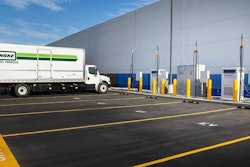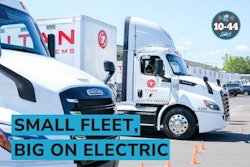Everything in trucking revolves around mileage. It's how freight is billed, it's how drivers are paid and its how maintenance and trade cycles are determined. The mileage range of battery electric trucks, however, leaves a lot to be desired in an industry that requires a lot of mileage and is soon to be required to use zero emission tractors.
The average length of haul for Old Dominion Freight Line this year is 925 miles, down about 1% from the year prior. Knight-Swift reported an average length of 388 miles, too down about 1% from 2022. Werner landed in the middle and its 612 loaded mile average is also down from the first six months of 2022, but by 13%.
Trend data from the American Transportation Research Institute (ATRI) shows the annual average miles driven by truck has been falling for more than a decade. The problem: all of these numbers, while down overall, are exponentially further than just about any battery electric truck on the road can drive on a single charge.
With the exception of Tesla's Semi, which claims an all electric range of 500 miles, the heavy BEV market is made up of a collection of trucks capable of roughly 250 miles per charge depending on spec.
Range is generally the first point of pushback on EVs in long haul trucking, but not only because the number is comparably small, but also because recharging the batteries is neither easy nor quick.
The average diesel pump dispenses fuel at a rate of 34 gallons per minute, so a driver getting 7 mpg could add 200 miles of range in about a minute. That same feat in an electric truck tethered to a high-output 350 kW charger is about 90 minutes; longer if the truck is taking charge from a lower kW-rated terminal.
In 90 minutes, a truck driver could pump more than 3,000 gallons of diesel – or a range of 21,420 miles for a 7 mpg tractor.
NACFE Director of Emerging Technologies Rick Mihelic noted faster diesel fill times can be misleading because a number of other factors, like DEF filing and waiting for a free pump (or finding one to begin with), are all time consuming on their own. But he concedes the length of time it takes to charge an electric truck does present an obstacle this early in their development cycle. However, diesel doesn't hold all the time advantages.
"Long routes of 500 to 650 miles per day for heavy-duty trucks will be challenging if mid-route charging is needed, because it will add additional lost driving time versus a diesel," he said. "If charging is done during rest periods, say overnight, then the electric trucks will actually increase the ability for the driver to be on the road actually moving versus having to fill-up with diesel."
Battery electric trucks thus far have have carved out a niche in drayage and local applications for this very reason, said North American Council for Freight Efficiency Director (NACFE) Executive Director Mike Roeth: because they can charge at the terminal, often overnight, and while they can work for many hours, the actual number of miles logged is relatively small.
"Fleets and drivers are both largely paid only for the route miles actually driven, not for time. Out of route miles, idle time, detention time, etc. are not revenue earning," Mihelic added. "Irrespective of the fuel energy type, time not driving always needs to be minimized."
Mihelic noted, like diesel pumps, not all electric pumps so-to-speak are created equal. The higher the kilowatt rating, the faster the terminal can deliver a charge.
To bridge the gap in current BEV local capabilities and long haul needs, WattEV co-founder and CEO Salim Youssefzadeh said a megawatt charging standard (MCS) is a necessity in the industry.
"With an MCS capable truck, the charge time comes down to 30 minutes. At this point, you are nearly at par with diesel operations and scheduling becomes less of an issue," he said. "To solve the range constraint, all of our depots are at most within a 175-mile radius of each other and are built to scale for future demand, which gets us to satisfying the long haul industry as well."
There is an entire system needed to get energy to any vehicle. For battery electrics, the diesel fuel supply chain is replaced with wires, transformers, controllers, etc. Each connection has to be correctly sized to deal with the worst case load expected, Mihelic said.
"Each connection, each link in the supply chain, can throttle energy. At the dispensing end from the charger to the vehicle, there are a number of constraining factors – more power means more heat, so steps are taken to actively cool higher power equipment and cables," he said. "The vehicle itself has to also be designed to handle the highest expected power. For example, you may have a 350 kW charger, but a vehicle may only be able to accept 150 kW."
The whole charging system has to be designed as a system and there may also be constraints on how much power is available at various times of day, or contractual agreements that limit peak power demand by a user so as to avoid higher rates, Mihelic said.
"Every link in the power supply chain can be a limiting factor. In the same way, from the oil well to the refinery to the storage tank to the pipeline to the distributor to the tanker to the fuel station to the pump – every one of those links can impact supply of diesel," he added. "The difference being only that the truck really is not a factor as the fuel pump fills a tank on the truck – a diesel fuel tank and truck has no impact on flow rate of fuel from the diesel fuel pump at the station."
The limiting factor on charging is primarily due to either a limit in voltage or current, Youssefzadeh said. For example, the chargers at the company's Port of Long Beach facility now are rated to 360 kW, however not all vehicles can take the full 360 kW due to a combination of battery voltage, Battery Management System (BMS) constraints, as well as current limits in cabling.
"As an example, if our charging cable is rated to 300 amps and a vehicle uses a 400 volt system, the max rate it can charge is at 120 kW (400 x 300)," he said. "As charging rates increase to the megawatt level, heating does become more intense, even as wires become thicker. But this is solved through liquid cooling within the charging cable as well as cooling within the vehicles' components. The MCS standard has been tested to go up to a 3.6 MW charging levels."












